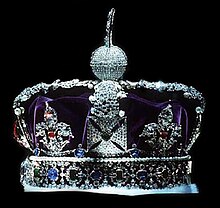


Animperial crown is a crown worn by an emperor. In the European cultural area, it also symbolizes the power of the empire in heraldic depictions.[1] The craftsmanship corresponded to the king's crown, with precious stones and pearls set into the precious metal frame for decoration. Their external form differed from crowns of the same period and the same reign. The use of Christian symbols to emphasize the divine rule of the emperor is the reason for the deviation.
In East Asia, there are several types of crowns worn by emperors, depending on the ritual or ceremony. Typical examples are the Chinese mianguan and the Japanese benkan. In external form, they are characterized by chains that hide the emperor's face.
Crowns in Europe during the Middle Ages varied in design:
An open crown is one which consists basically of a golden circlet elaborately worked and decorated with precious stones or enamels. ... The medieval French crown was of this type. ... the closed crown, which had bands of metal crossing usually from one side to the other and from back to front so that they met in the middle, at the top of the head. ... These arches are in part utilitarian, since they serve to strengthen the crown, in part decorative, since they are normally made to serve as supports for a central cross or jewel, and in part traditional, since a contributing element to the evolution of many medieval crowns was the structure of the early Germanic helmet, which had metal bands crossing at the top of the head to protect the skull from injury.
A special case of a closed crown was that of the Holy Roman Empire. This was originally an open crown, made up of eight separate richly jewelled sections incorporating four magnificent enamelled plaques, but the Emperor Conrad II (1024–39) had added to it a kind of jewelled crest, running from front to back, to which he had thoughtfully attached his name, CHVONRADVS DEI GRATIA ROMANORV(M) IMPERATOR AVG(VSTVS). This jewelled crest was so closely associated with the notion of the imperial office that when the Habsburgs made a new imperial crown in the 15th century in which they incorporated two large cusps resembling a mitre seen sideways, they provided it with a similar crest running from front to back and topped with a central jewel. ... Strictly speaking, therefore, the only type of crown whose characteristics can properly be regarded as imperial was one with a single crest running from front to back. In practice, in countries unfamiliar with closed crowns at all, any kind of closed crown was assumed to be imperial in character.
— Philip Grierson[2]
During the Middle Ages the crowns worn by English kings had been described as both closed (or arched) and open designs. This was in contrast with kings of France who always wore an open crown. However, there is academic debate on how often closed crowns were used in England during this period, as the first unequivocal use of the closed crown was by Henry IV of England at his coronation on 13 October 1399.[3][4] However his effigy on his tomb in Canterbury Cathedral wears an open crown, so the link in England between the style of the crown and its representation as that worn by a king and an emperor was not established.[4] The use of a closed crown may have been adopted by the English as a way of distinguishing the English crown from the French crown,[5] but it also had other meanings to some. For example, Henry V of England wore a helmet-crown of the arched type at the Battle of Agincourt which the French knight St. Remy commented was "like the imperial crown".[6]
The association of the closed crown with imperial crowns was already established in Continental Europe by the late 14th century, for example the florins minted for Charles IV, Holy Roman Emperor) sometimes show him with a closed crown (though on the commoner variety, the crown is open). A miniature picture in the Chronica Aulae Regiae written in the great abbey outside Prague depicts his mother Elizabeth, a queen of Bohemia, wearing an open crown, while his two wives, who had imperial titles, have closed ones.[7]
During the machinations that surrounded the introduction of the imperial crown under Henry VIII (see the section below Legal usage), the closed crown, became associated as a symbolic representation of the English Crown as an imperial crown,[8][a][b] and has remained so until this day.[11]

A list of prominent examples of depictions of imperial crowns displayed atop heraldic achievements or as heraldic charge includes:
Because Pope Clement VII would not grant Henry VIII of Englandanannulment of his marriage to Catherine of Aragon, the English Parliament passed the Act in Restraint of Appeals (1533) in which it was explicitly stated that
The next year the Act of Supremacy (1534) explicitly tied the headship of the church to the imperial crown:
During the reign of Mary I the First Act of Supremacy was annulled, but during the reign of Elizabeth I the Second Act of Supremacy, with similar wording to the First Act, was passed in 1559. During the English Interregnum the laws were annulled, but the acts which caused the laws to be in abeyance were themselves, deemed to be null and void by the Parliaments of the English Restoration, so by act of Parliament The Crown of England and (later the British and UK crowns) are imperial crowns.